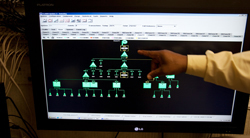 Every day, all around the world, hospital staff turn to a transport network that the Internet and the latest Silicon Valley wizardry cannot match — the pneumatic tube system. Designed primarily to move paper, this cutting edge technology in the 19th century drove commercial businesses — such as postal services and department stores — whose physical size demanded something faster than standard human pace. With the arrival of the Internet, pneumatic tube systems lost their value for many industries. But this technology not only endures — but thrives — in hospitals, particularly with the introduction of wider diameter containers and use of air flow to slow down the containers for a soft landing at their destination stations so to avoid damaging sensitive lab samples.
Every day, all around the world, hospital staff turn to a transport network that the Internet and the latest Silicon Valley wizardry cannot match — the pneumatic tube system. Designed primarily to move paper, this cutting edge technology in the 19th century drove commercial businesses — such as postal services and department stores — whose physical size demanded something faster than standard human pace. With the arrival of the Internet, pneumatic tube systems lost their value for many industries. But this technology not only endures — but thrives — in hospitals, particularly with the introduction of wider diameter containers and use of air flow to slow down the containers for a soft landing at their destination stations so to avoid damaging sensitive lab samples.
 Just look at Stanford Hospital in California — which has one of the largest pneumatic tube systems in the U.S. With four miles of tubing woven behind walls from basement to rooftop, its pneumatic tube system shuttles foot-long containers carrying everything from lab specimens, blood products, and medications to instruments, as well hard-copy patient X-rays and older medical records. On the campus of the Stanford Hospital and Clinics — where a quarter-mile’s distance might separate a tissue specimen from its destination lab — making good time means better quality medicine.
Just look at Stanford Hospital in California — which has one of the largest pneumatic tube systems in the U.S. With four miles of tubing woven behind walls from basement to rooftop, its pneumatic tube system shuttles foot-long containers carrying everything from lab specimens, blood products, and medications to instruments, as well hard-copy patient X-rays and older medical records. On the campus of the Stanford Hospital and Clinics — where a quarter-mile’s distance might separate a tissue specimen from its destination lab — making good time means better quality medicine.
To support 7,000 deliveries a day, its infrastructure is a sophisticated design of switching points, waiting areas, and sending and receiving points. It hosts 124 stations (every nursing unit has its own), 141 transfer units, 99 inter-zone connectors, and 29 blowers. To help alert employees to the arrival of containers, the system has more than three dozen different combinations of chiming tones. While crossing the hospital’s vast premises — including the Blake Wilbur Outpatient Clinic, the Stanford Cancer Center, and Packard Children’s Hospital — the containers reach speeds topping 18 miles per hour (or 25 feet per second). According to the hospital’s chief engineer, the system is operational 98.8 percent of the time and no cylinder has ever gotten stuck in a tube even though tubes converge at key points. It is also a work in progress as the hospital continues to expand and locations change.
While pneumatic tube systems are not exactly a hot new technology, they are not about to be replaced. It is still the fastest way to transport a small object across a quarter-mile wide hospital campus.
Photo source: Stanford School of Medicine website.
This article is an update of a previous post.
